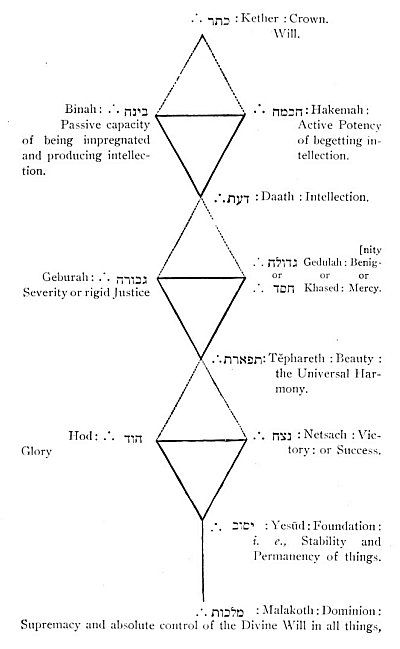The Cross has been a sacred symbol from the earliest Antiquity. It is found upon all the enduring monuments of the world, in Egypt, in Assyria, in Hindostan, in Persia, and on the Buddhist towers of Ireland. Buddha was said to have died upon it. The Druids cut an oak into its shape and held it sacred, and built their temples in that form. Pointing to the four quarters of the world, it was the symbol of universal nature. It was on a cruciform tree, that Chrishna was said to have expired, pierced with arrows. It was revered in Mexico.
But its peculiar meaning in this Degree, is that given to it by the Ancient Egyptians. Thoth or Phtha is represented on the oldest monuments carrying in his hand the Crux Ansata, or Ankh, [a Tau cross, with a ring or circle over it]. He is so seen on the double tablet of Shufu and Noh Shufu, builders of the greatest of the Pyramids, at Wady Meghara, in the peninsula of Sinai. It was the hieroglyphic for life, and with a triangle prefixed meant life-giving. To us therefore it is the symbol of Life–of that life
p. 291
that emanated from the Deity, and of that Eternal Life for which we all hope; through our faith in God’s infinite goodness.
The ROSE, was anciently sacred to Aurora and the Sun. It is a symbol of Dawn, of the resurrection of Light and the renewal of life, and therefore of the dawn of the first day, and more particularly of the resurrection: and the Cross and Rose together are therefore hieroglyphically to be read, the Dawn of Eternal Life which all Nations have hoped for by the advent of a Redeemer.
The Pelican feeding her young is an emblem of the large and bountiful beneficence of Nature, of the Redeemer of fallen man, and of that humanity and charity that ought to distinguish a Knight of this Degree.
The Eagle was the living Symbol of the Egyptian God Mendes or Menthra, whom Sesostris-Ramses made one with Amun-Re, the God of Thebes and Upper Egypt, and the representative of the Sun, the word RE meaning Sun or King.
The Compass surmounted with a crown signifies that notwithstanding the high rank attained in Masonry by a Knight of the Rose Croix, equity and impartiality are invariably to govern his conduct.
To the word INRI, inscribed on the Crux Ansata over the Master’s Seat, many meanings have been assigned. The Christian Initiate reverentially sees in it the initials of the inscription upon the cross on which Christ suffered–Jesus Nazarenus Rex Iudæorum. The sages of Antiquity connected it with one of the greatest secrets of Nature, that of universal regeneration. They interpreted it thus, Igne Natura renovator integra; [entire nature is renovated by fire]: The Alchemical or Hermetic Masons framed for it this aphorism, Igne nitrum roris invenitur. And the Jesuits are charged with having applied to it this odious axiom, Justum necare reges impios. The four letters are the initials of the Hebrew words that represent the four elements–Iammim, the seas or water; Nour, fire; Rouach, the air, and Iebeschah, the dry earth. How we read it, I need not repeat to you.
The Cross, ×, was the Sign of the Creative Wisdom or Logos, the Son of God. Plato says, “He expressed him upon the Universe in the figure of the letter X. The next Power to the Supreme God was decussated or figured in the shape of a Cross on the Universe.” Mithras signed his soldiers on the forehead with a
p. 292
Cross.![]() is the mark of 600, the mysterious cycle of the Incarnations. We constantly see the Tau and the Resh united thus
is the mark of 600, the mysterious cycle of the Incarnations. We constantly see the Tau and the Resh united thus![]() . These two letters, in the old Samaritan, as found in Arius, stand, the first for 400, the second for 200=600. This is the Staff of Osiris, also, and his monogram, and was adopted by the Christians as a Sign. On a medal of Constantius is this inscription, “In hoc signo victor eris
. These two letters, in the old Samaritan, as found in Arius, stand, the first for 400, the second for 200=600. This is the Staff of Osiris, also, and his monogram, and was adopted by the Christians as a Sign. On a medal of Constantius is this inscription, “In hoc signo victor eris![]() .”An inscription in the Duomo at Milan reads, “
.”An inscription in the Duomo at Milan reads, “![]() et
et![]() Christi • Nomina • Sancta • Teneï.”
Christi • Nomina • Sancta • Teneï.”

Moe is the founder of GnosticWarrior.com. He is a father, husband, author, martial arts black belt, and an expert in Gnosticism, the occult, and esotericism.





